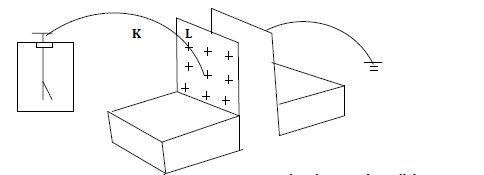Apparatus:
2 aluminium plates, K and L of dimensions 25cm * 25cm,Insulating polythene support, uncharged electroscope, Glass plate, earthing wireand a free wire.

Procedure
- Fix the plates on the insulating support so that they stand parallel and close to each other as shown above.
- Charge plate K to a high voltage and then connect it to the uncharged electroscope. Earth the second plate, L.
- While keeping the area of overlap, A the same vary the distance of separation, d and observe the leaf divergence.
- While keeping the distance of separation, d constant vary the area of overlap, A and observe the leaf divergence.
- While keeping both the area of overlap and the distance of separation, d constant introduce the glass plate between the plates of the capacitor and observe what happens to the leaf.
Observations
1. When the distance of separation is increased the leaf divergence also increased.
2. When the area of overlap is increased the leaf divergence decreased.
3. When the glass plate is introduced between the plates, the leaf divergence increased.
Note that the leaf divergence here is a measure of the potential, V of plate K. Hence the larger the divergence the greater the potential and thus the lower the capacitance ( since C = Q/V, but Q is constant).
Conclusion
From the above observations, it follows that the capacitance is directly proportional to the area of overlap between the plates and inversely proportional to the distance of separation. It also depends on the nature of the dielectric material.
C ? A/d
C = eA/d where e is a constant called permittivity of the dielectric material (epsilon).
If between the plates is a vacuum, then e = e0, known as epsilon nought and is given by 6.85 * 10
-12 Fm
-1. Hence C = e0A/d
sharon kalunda answered the question on
April 24, 2019 at 07:53